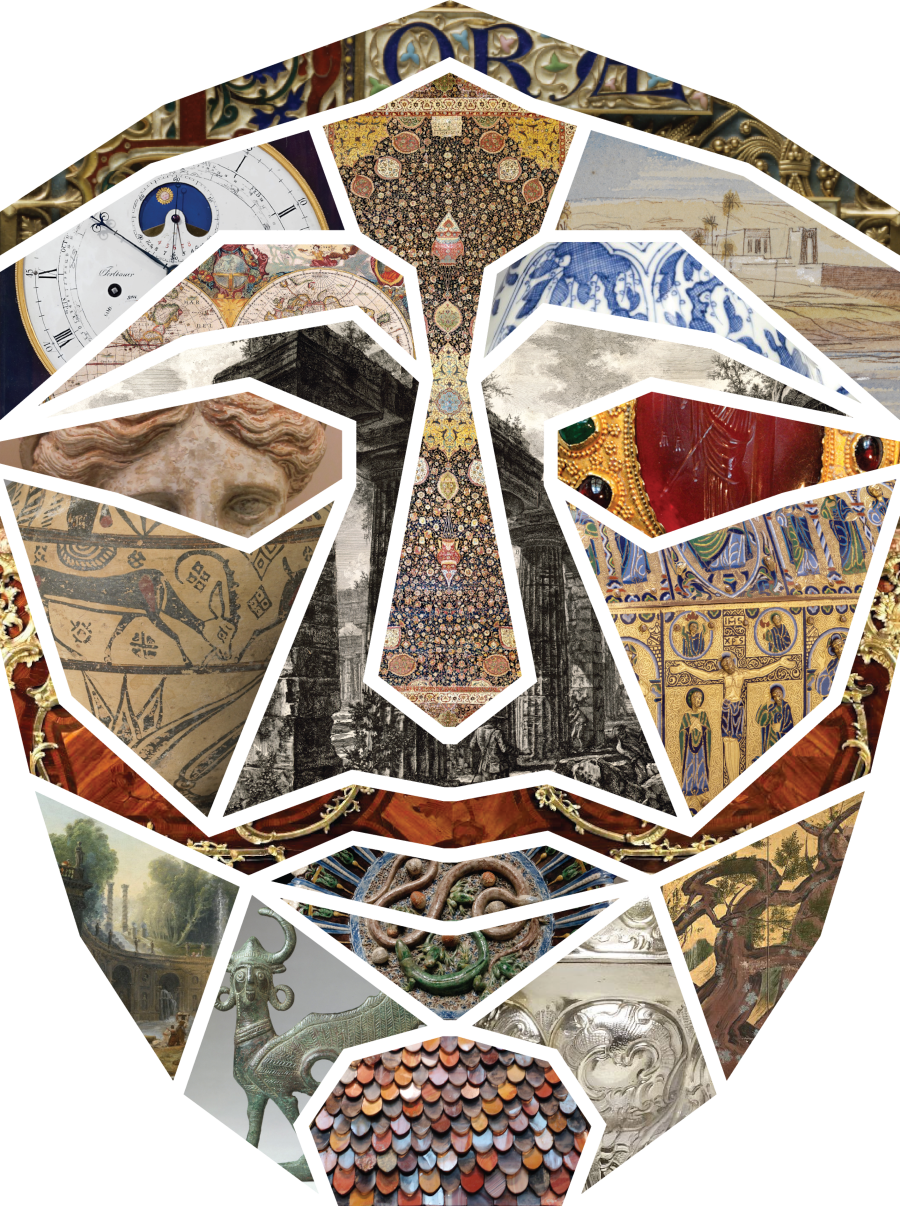My Store
[Sold] An Exquisite Bavarian Reliquary Containing the Forearm of St. Gereon
[Sold] An Exquisite Bavarian Reliquary Containing the Forearm of St. Gereon
Couldn't load pickup availability
DESCRIPTION
Title: The Ulna of St. Gereon of Cologne (Martyr) (Born: N/A, Germany- Died: 304 AD, Germany)
Maker, Location, Date: German, C.1450
Materials: Gilt wood (limewood?) bone, feathers, silver wire, coloured beads
Dimensions: H 78 x L 17 x B 12 cm
Provenance: The Chapel of a Noble Family, Mdina, Malta (according to Obelisk Auctioneers, Attard, Malta)
An intriguing Roman Catholic sacred reliquary displays the right-hand ulna of Martyr and Saint Gereon of Cologne. The deeply carved limewood (?) forearm is robed and gilt whilst the hand is ebonised, and the plinth that continues at the base of the arm is both gilt and painted, an elegant extension to the above that exemplifies the style of the Middle Ages. A long strip of glass runs across the front of the reliquary, which acts as a display window for the actual relic. On the verso, one finds a cloth-covered insert nailed into the structure with hand-forged nails and tied with a strap, further sealed by many wax seals.
The sacred bone was lightly wrapped in a linen cloth with an applique of silver wire, green feathers and coloured beads—a label inscribed with ‘S. Gereonis M.’ has been placed on top of the ulna.
Ten wax seals can be found on the verso, which are divided into three types. The oldest, a golden-brown seal, can be located twice and in trace amounts (barely visible). The second layer features an ochre-orange red seal portraying the insignia of a bishop (auxiliary?) under a wide-brimmed galero, the field of which is azure (horizontal lines) and whose charges include a cross atop 3(?) balls(?) and three stars/flowers(?) inscribed with ‘vicar capitular’[1], the rest of the text is missing[2].
The third seal, brick red, displays the emblem of the Jesuit Convent and refers to the parish of Freising, Germany[3].
[1] ecclesiastic selected by a Roman Catholic cathedral chapter to administer the affairs of a vacant see until a new bishop is appointed
[2] Research is underway to determine the owner of these arms.
[3] Research is underway to determine more about these arms and their relation to the object.
More about arm reliquaries:
This type of reliquary/relic is known as a speaking relic, the most revered category of its type, because its outer shell communicates what kind of relic is housed inside.
Arm reliquaries were popular because they could easily be set standing upright on or near an altar, but perhaps more so because of their sacred gesture. By showing a saint’s hand as a blessing, clergy could carry or display the reliquary, animating a Saint’s body during liturgical celebrations or processions. In this way, the saint could bless, touch, and heal the faithful with their hand, which came in handy in the case of St. Gereon, as he is known to be the patron saint invoked by those suffering from migraines or headaches. Such speaking reliquaries became popular throughout the Medieval period as churches on major pilgrimage routes vied for the pilgrims’ attention.
Most sacred relics on the market feature minuscule labelled fragments of holy objects or bones without authenticating their claims. In this case, the full ulna (the outer bone in the forearm connecting the wrist to the elbow) has been encased and sealed by no less than three different wax seals located at the precise points of opening the relic, and the nails hammered into the wooden matrix to seal the relic. These seals were appended as an attestation, directly applied once the wax had already been laid on the matrix.
About Saint Gereon of Cologne:
St. Gereon of Cologne (N/A-304 AD) was born and died in Germany and served as an Imperial Roman soldier. In sacred art, he is usually represented as a soldier or medieval knight, and because of this, he became a famous military saint. St.Gereon and other saints in his troop were beheaded and died as martyrs of the faith. He is the patron saint of all those suffering from migraines or headaches. St. Gereon’s Basilica in Cologne is dedicated to him, which also houses the Convent of St.Gereon.
Condition:
It is in excellent condition considering its age. A few old and inactive woodworm ‘flight holes’.
References:
- Bedos-Rezak, Brigitte Miriam.’’In Search of a Semiotic Paradigm: The Matter of Sealing in Medieval Thought and Praxis (1050–1400)
- Boehm, Barbara Drake. “Relics and Reliquaries in Medieval Christianity.” In Heilbrunn Timeline of Art History. New York: The Metropolitan Museum of Art, 2000–.
- Bagnoli, M., and K. Gerry. The Medieval World. Baltimore, Maryland, Walters ArtMuseum, 2011.
- Bagnoli, “Treasures of Heaven: Saints, Relics, and Devotion in Medieval Europe”. Cleveland: Cleveland Museum of Art, 2010
- McLaughlin, Meredith. “Arm Reliquary: Journey from Divine to Fine Art.”Medieval Art and the American Public: A Digital Narrative, FordhamUniversity.
- Freeman, Charles. ‘‘Holy Bones, Holy Dust: How Relics Shaped the History of Medieval Europe’’
- “Gereon (Geron) and Companions.” The Oxford Dictionary of Saints, 2011
Share
![[Sold] An Exquisite Bavarian Reliquary Containing the Forearm of St. Gereon](http://artemisialtd.com/cdn/shop/files/IMG_0294-600x600.jpg?v=1720015844&width=1445)
![[Sold] An Exquisite Bavarian Reliquary Containing the Forearm of St. Gereon](http://artemisialtd.com/cdn/shop/files/4I8A8287-600x600.jpg?v=1720014990&width=1445)
![[Sold] An Exquisite Bavarian Reliquary Containing the Forearm of St. Gereon](http://artemisialtd.com/cdn/shop/files/4I8A8294-600x600.jpg?v=1720015016&width=1445)
![[Sold] An Exquisite Bavarian Reliquary Containing the Forearm of St. Gereon](http://artemisialtd.com/cdn/shop/files/DD-080324-084-600x406.jpg?v=1720015023&width=1445)
![[Sold] An Exquisite Bavarian Reliquary Containing the Forearm of St. Gereon](http://artemisialtd.com/cdn/shop/files/4I8A8300-600x600.jpg?v=1720015036&width=1445)
![[Sold] An Exquisite Bavarian Reliquary Containing the Forearm of St. Gereon](http://artemisialtd.com/cdn/shop/files/Artemisia-HR-5420-600x400.jpg?v=1720015042&width=1445)
![[Sold] An Exquisite Bavarian Reliquary Containing the Forearm of St. Gereon](http://artemisialtd.com/cdn/shop/files/IMG_0295-600x600.jpg?v=1720015063&width=1445)
![[Sold] An Exquisite Bavarian Reliquary Containing the Forearm of St. Gereon](http://artemisialtd.com/cdn/shop/files/IMG_0137-Edit-600x600.jpg?v=1720015066&width=1445)










